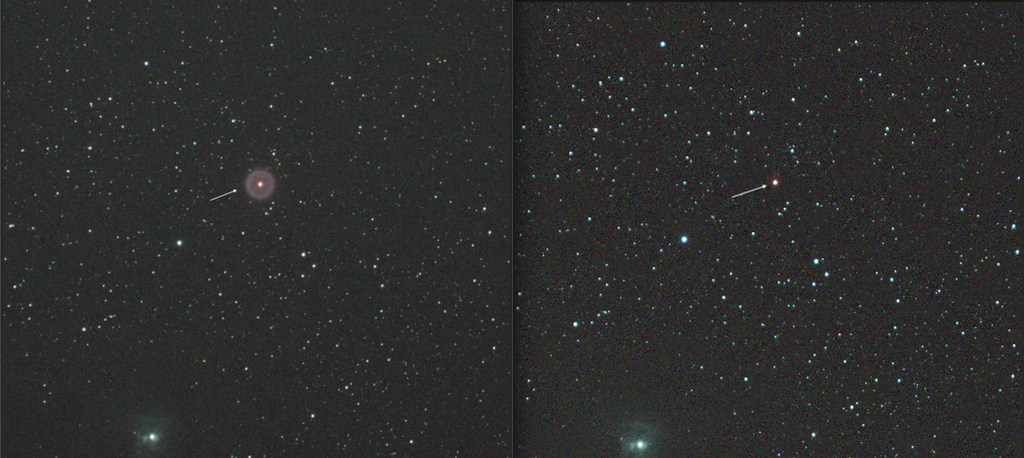 I had this problem with two of my dual narrowband filters: huge halos around some stars, although I noticed that the affected stars are not always the visually brightest in the image. I also noticed in the last series of photographs that it seems to be particularly bad for stars that shine strongly in the red spectrum. My suspicion: the filter coatings have a problem in the infrared spectrum, something unpleasant is happening that leads to this false light - whatever it is. My two affected filter candidates are: the Optolong L-extreme and the dual narrowband filter from ZWO. As a test, I installed a UV/IR-cut filter from Baader in front of the dual narrow-band filter from ZWO, and the halos were actually completely eliminated. So if you also have this problem, just try it out and see if it helps. I have to mention: this is happening at f2 with my Samyang 135mm Lens. Probably f2 is amplifying any halo-related filter-problems. I released both filters from it's housing and installed both as a stack in the holder from baader because there is more space. UV/IR-cut filter at the scope-side, dual-narrowband at the sensor-side. It worked perfectly well for me, what do you think? Does the light-transmission suffer significantly with this approach? 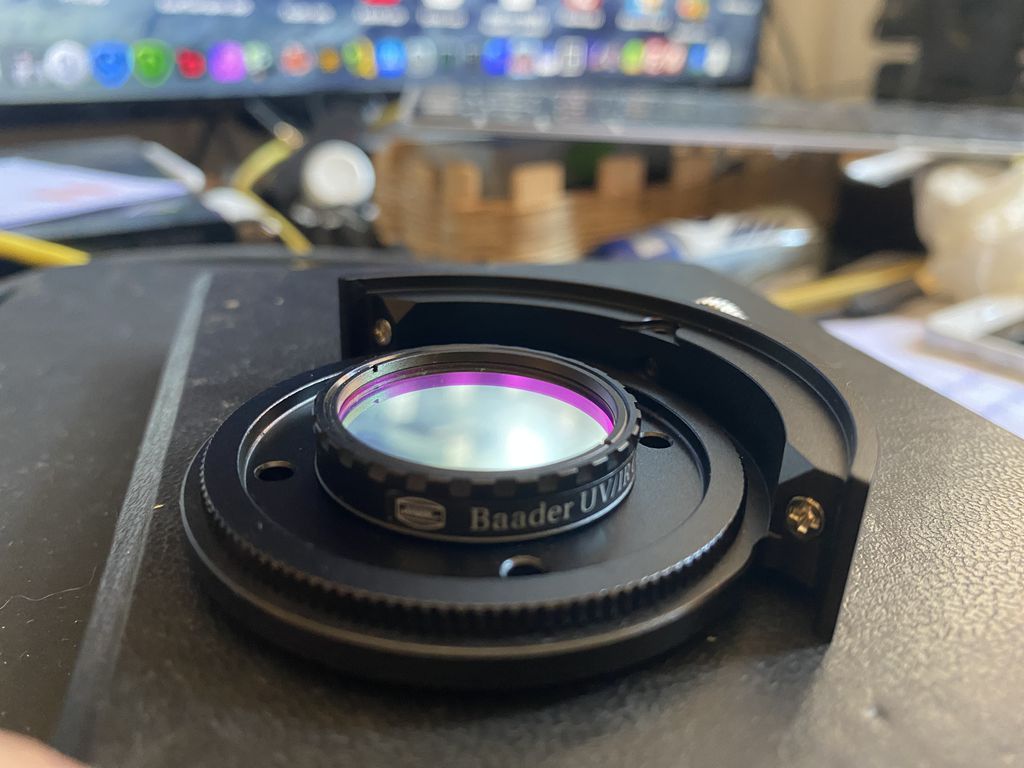 Picture shows the installed filter-stack.
|
You cannot like this item. Reason: "ANONYMOUS".
You cannot remove your like from this item.
Editing a post is only allowed within 24 hours after creating it.
You cannot Like this post because the topic is closed.
Copy the URL below to share a direct link to this post.
This post cannot be edited using the classic forums editor.
To edit this post, please enable the "New forums experience" in your settings.
Which camera are you using? Asking this because several OSC have a protective glass in front of the sensor of which it is claimed that it acts as a UV/IR filter.
I have halo's with a [O III] filter, my mono camera has only AR glass as a protection and I have been thinking since a few weeks about replacing it with the same size (UV/IR blocking) glass used on the OSC version.
|
You cannot like this item. Reason: "ANONYMOUS".
You cannot remove your like from this item.
Editing a post is only allowed within 24 hours after creating it.
You cannot Like this post because the topic is closed.
Copy the URL below to share a direct link to this post.
This post cannot be edited using the classic forums editor.
To edit this post, please enable the "New forums experience" in your settings.
Habib Sekha:
Which camera are you using? Asking this because several OSC have a protective glass in front of the sensor of which it is claimed that it acts as a UV/IR filter.
I have halo's with a [O III] filter, my mono camera has only AR glass as a protection and I have been thinking since a few weeks about replacing it with the same size (UV/IR blocking) glass used on the OSC version. It does not matter if the glass in the sensor-window has UV/IR-cut filtering, because this is happening in the coating of the duo-narrowband filter in front of the sensor-window. The coatings somehow seem to bend or distract this wavelegth into a visible halo, don't ask me how. I am just sharing what I observed.
|
You cannot like this item. Reason: "ANONYMOUS".
You cannot remove your like from this item.
Editing a post is only allowed within 24 hours after creating it.
You cannot Like this post because the topic is closed.
Copy the URL below to share a direct link to this post.
This post cannot be edited using the classic forums editor.
To edit this post, please enable the "New forums experience" in your settings.
My L-Extreme never gives these sort of halos but, as tested, the L-Enhance has shown some moderate halos with carbon stars and Mira-type ones. Rare enough not to bother me in the least, at f/2.8 anyway.
|
You cannot like this item. Reason: "ANONYMOUS".
You cannot remove your like from this item.
Editing a post is only allowed within 24 hours after creating it.
You cannot Like this post because the topic is closed.
Copy the URL below to share a direct link to this post.
This post cannot be edited using the classic forums editor.
To edit this post, please enable the "New forums experience" in your settings.
andrea tasselli:
My L-Extreme never gives these sort of halos but, as tested, the L-Enhance has shown some moderate halos with carbon stars and Mira-type ones. Rare enough not to bother me in the least, at f/2.8 anyway. I had this halo especially at this star with both filters at f2 - the L-extreme and the ZWO. No clouds by the way.
|
You cannot like this item. Reason: "ANONYMOUS".
You cannot remove your like from this item.
Editing a post is only allowed within 24 hours after creating it.
You cannot Like this post because the topic is closed.
Copy the URL below to share a direct link to this post.
This post cannot be edited using the classic forums editor.
To edit this post, please enable the "New forums experience" in your settings.
It only happened here (Sh2-240), note this is a 2hr integration: 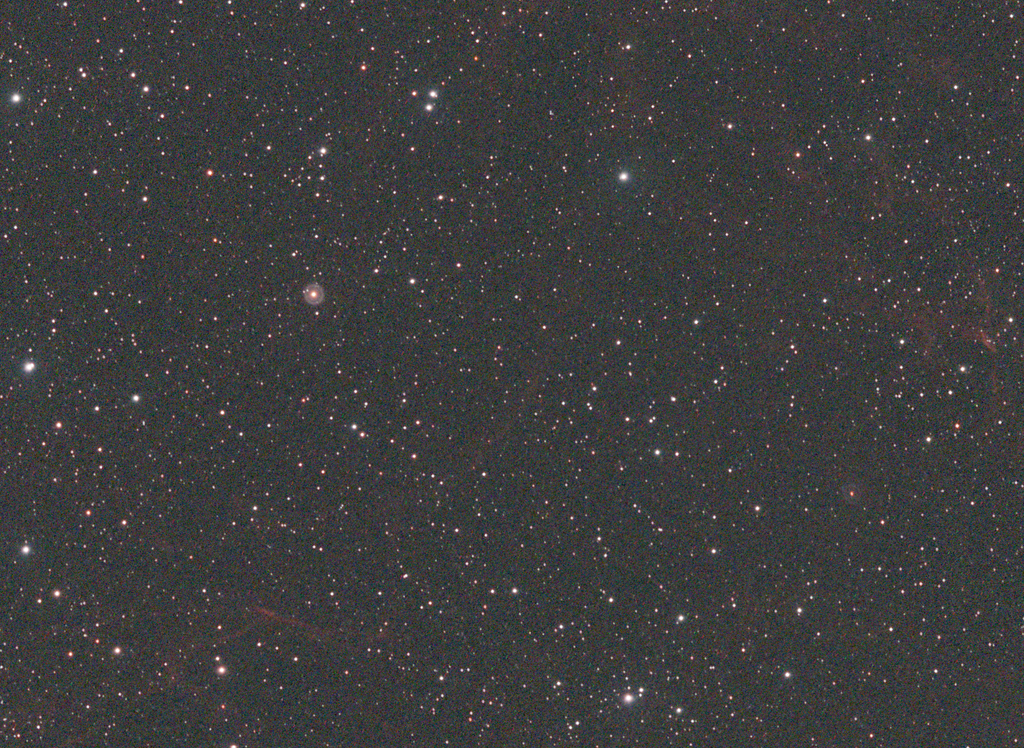 |
You cannot like this item. Reason: "ANONYMOUS".
You cannot remove your like from this item.
Editing a post is only allowed within 24 hours after creating it.
You cannot Like this post because the topic is closed.
Copy the URL below to share a direct link to this post.
This post cannot be edited using the classic forums editor.
To edit this post, please enable the "New forums experience" in your settings.
I had halos around bright stars with an L-Exteme https://www.astrobin.com/full/f1nqu5/0/ . I sold it and bought an L-Ultimate with the idea it wouldn't halo as bad. Haven't been able to test it as we're finally nearing the end of the rainy season. Although, to be honest the halos don't really bother me that much. My images are mediocre at best anyway  I meant to say it was with a WO GT81 and a ASI294MC Pro Mike
|
You cannot like this item. Reason: "ANONYMOUS".
You cannot remove your like from this item.
Editing a post is only allowed within 24 hours after creating it.
You cannot Like this post because the topic is closed.
Copy the URL below to share a direct link to this post.
This post cannot be edited using the classic forums editor.
To edit this post, please enable the "New forums experience" in your settings.
To me seems more likely an UV leak bumped down in the visible rather than an IR leak bumped up in the visible, of which I never heard of.
|
You cannot like this item. Reason: "ANONYMOUS".
You cannot remove your like from this item.
Editing a post is only allowed within 24 hours after creating it.
You cannot Like this post because the topic is closed.
Copy the URL below to share a direct link to this post.
This post cannot be edited using the classic forums editor.
To edit this post, please enable the "New forums experience" in your settings.
My trouble-star is T-Cephei, it is a Mira variable star, so it is very red but not brighter in infrared than in visible light (as far as I understood). Confusing, but if it was not the IR-filtering that eliminated the halo, was it just the additional glass-layer? I don't know.
|
You cannot like this item. Reason: "ANONYMOUS".
You cannot remove your like from this item.
Editing a post is only allowed within 24 hours after creating it.
You cannot Like this post because the topic is closed.
Copy the URL below to share a direct link to this post.
This post cannot be edited using the classic forums editor.
To edit this post, please enable the "New forums experience" in your settings.
Walter Leonhard Schramböck:
My trouble-star is T-Cephei, it is a Mira variable star, so it is very red but not brighter in infrared than in visible light (as far as I understood). Confusing, but if it was not the IR-filtering that eliminated the halo, was it just the additional glass-layer? I don't know. Try and guess which star T Cephei is! Left is visible and right is around 1200 nm, right around the QE cutoff for Silicon detectors. From what I see this all points to the issue being an IR leak, this halo in particular is light which has not been brought to a tight focus. By including an additional UV/IR cut without a leak, the halo disappears. 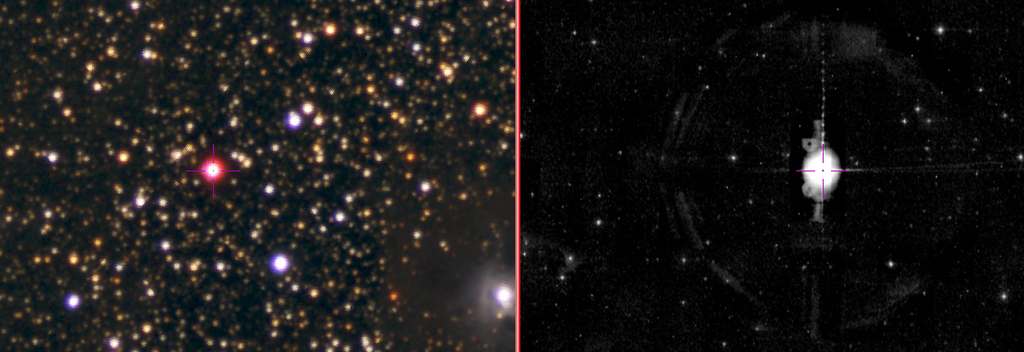 |
You cannot like this item. Reason: "ANONYMOUS".
You cannot remove your like from this item.
Editing a post is only allowed within 24 hours after creating it.
You cannot Like this post because the topic is closed.
Copy the URL below to share a direct link to this post.
This post cannot be edited using the classic forums editor.
To edit this post, please enable the "New forums experience" in your settings.
The aperture has influence to the angle of the incoming light, and because these are interference filters, this angle can cause problems in these interferences at certain wavelengths because the coatings are calculated for a certain aperture range respectively angle.
So f2 makes it a Lot worse.
|
You cannot like this item. Reason: "ANONYMOUS".
You cannot remove your like from this item.
Editing a post is only allowed within 24 hours after creating it.
You cannot Like this post because the topic is closed.
Copy the URL below to share a direct link to this post.
This post cannot be edited using the classic forums editor.
To edit this post, please enable the "New forums experience" in your settings.
I’ve been curious about this as well, and in one issue I was troubleshooting some time ago noticed it was more prominent in stars with a strong IR signal.
You might be on to something. If the filter is leaking a fair amount of IR light, contrary to the published specifications, that might be causing an internal reflection, and thus the haloing.
Earlier this year a YouTuber did some spectrum tests on several popular dual-bandpass narrowband filters and found that there seemed to be quite a bit of variation from specification in some, including some pretty material leaking in the spectrum published specifications indicated should be blocked. And a couple months later that video vanished. I can’t help but to wonder if they were contacted with a legal threat or the like. I’ve also noticed some vendors, like IDAS, seem to go a lot more out of their way to publish accurate spectrum charts than others, which like to indicate that even their cheap filters leak no material light out of spectrum. (Deliberately omitting their name at this point out of respect for whatever reason they chose to take the video down.)
Unfortunately the only dual-bandpass narrowband filter I own anymore is an IDAS NBZ-II, and it seems to have no haloing issue to test.
|
You cannot like this item. Reason: "ANONYMOUS".
You cannot remove your like from this item.
Editing a post is only allowed within 24 hours after creating it.
You cannot Like this post because the topic is closed.
Copy the URL below to share a direct link to this post.
This post cannot be edited using the classic forums editor.
To edit this post, please enable the "New forums experience" in your settings.
James Thompson has investigated filter induced halos at some length - I recommend reading his 2022 and 2023 publications. In his 2023 paper he concludes: - "Filter induced artefacts are caused by reflections both from the exterior surfaces of the filter, and reflections occurring within the filter. Artefacts commonly identified as halos are primarily due to intra-filter reflections. Ghost images are due to reflections between the filter and other surfaces such as the camera sensor window or a nearby focal reducer/field flattener. Filter manufacturers can do little if anything to reduce reflections from surfaces ahead of the filter in your optical train.
- The distance of the filter from the sensor does not impact the appearance of the halo. Its size is dependant only on the thickness of the filter glass and the scope focal ratio. Thicker glass or faster focal ratio both result in larger halos.
- The extent to which a halo is produced depends on the surface temperature of the star. Comparing stars with the same visual magnitude, very hot stars (>10,000K) and very cool stars (<5000K) will produce brighter halos than moderate temperature stars. Since filters are commonly used for imaging emission nebulae in star forming regions, there is likely an observing bias in the astrophotography community towards scenes containing young stars that are both hot and bright.
- A filter’s tendency to produce halos is highly dependant on its off-band blocking performance. From the 45 filters tested, all those with off-band blocking >OD4 had little or no discernable halo. For filters with blocking below OD4, secondary effects like filter reflectivity become more important.
- Application of an anti-reflective coating on the camera side of the filter can help to reduce the appearance of halos, although the magnitude of the impact is less than increasing off-band blocking. An anti-reflective coating designed to operate in the blue part of the spectrum is most effective at reducing halo brightness, especially for very hot stars.
- Narrowband or multi-narrowband filters are more prone to halos because by design they are reflecting a large amount of off-band light. Application of high off-band blocking and anti-reflective coatings on the camera side of the filter are very important design requirements for these types of filters. They are especially prone to halos on fast optics like RASA or Hyperstar systems because of the fast f-ratio, but they are also prone to ghost images off of the corrective optics that sit immediately in front of the filter. This is not the fault of the filter manufacturer though, it is a result of the reflectiveness of the scope optics."
2022 https://www.researchgate.net/publication/365687384_Understanding_Filter_Induced_Star_Halos 2023 https://www.researchgate.net/publication/377357274_Understanding_Filter_Induced_Star_Halos |
You cannot like this item. Reason: "ANONYMOUS".
You cannot remove your like from this item.
Editing a post is only allowed within 24 hours after creating it.
You cannot Like this post because the topic is closed.
Copy the URL below to share a direct link to this post.
This post cannot be edited using the classic forums editor.
To edit this post, please enable the "New forums experience" in your settings.
Mike Dobres:
James Thompson has investigated filter induced halos at some length - I recommend reading his 2022 and 2023 publications. In his 2023 paper he concludes:
- "Filter induced artefacts are caused by reflections both from the exterior surfaces of the filter, and reflections occurring within the filter. Artefacts commonly identified as halos are primarily due to intra-filter reflections. Ghost images are due to reflections between the filter and other surfaces such as the camera sensor window or a nearby focal reducer/field flattener. Filter manufacturers can do little if anything to reduce reflections from surfaces ahead of the filter in your optical train.
- The distance of the filter from the sensor does not impact the appearance of the halo. Its size is dependant only on the thickness of the filter glass and the scope focal ratio. Thicker glass or faster focal ratio both result in larger halos.
- The extent to which a halo is produced depends on the surface temperature of the star. Comparing stars with the same visual magnitude, very hot stars (>10,000K) and very cool stars (<5000K) will produce brighter halos than moderate temperature stars. Since filters are commonly used for imaging emission nebulae in star forming regions, there is likely an observing bias in the astrophotography community towards scenes containing young stars that are both hot and bright.
- A filter’s tendency to produce halos is highly dependant on its off-band blocking performance. From the 45 filters tested, all those with off-band blocking >OD4 had little or no discernable halo. For filters with blocking below OD4, secondary effects like filter reflectivity become more important.
- Application of an anti-reflective coating on the camera side of the filter can help to reduce the appearance of halos, although the magnitude of the impact is less than increasing off-band blocking. An anti-reflective coating designed to operate in the blue part of the spectrum is most effective at reducing halo brightness, especially for very hot stars.
- Narrowband or multi-narrowband filters are more prone to halos because by design they are reflecting a large amount of off-band light. Application of high off-band blocking and anti-reflective coatings on the camera side of the filter are very important design requirements for these types of filters. They are especially prone to halos on fast optics like RASA or Hyperstar systems because of the fast f-ratio, but they are also prone to ghost images off of the corrective optics that sit immediately in front of the filter. This is not the fault of the filter manufacturer though, it is a result of the reflectiveness of the scope optics."
2022https://www.researchgate.net/publication/365687384_Understanding_Filter_Induced_Star_Halos 2023https://www.researchgate.net/publication/377357274_Understanding_Filter_Induced_Star_Halos Thank you. I will read into this. So far I found the solution for my particular setup.
|
You cannot like this item. Reason: "ANONYMOUS".
You cannot remove your like from this item.
Editing a post is only allowed within 24 hours after creating it.
You cannot Like this post because the topic is closed.
Copy the URL below to share a direct link to this post.
This post cannot be edited using the classic forums editor.
To edit this post, please enable the "New forums experience" in your settings.
Short non-technical and practical version of the above is that the better (and often much more expensive) filters (Astro-Don, Chroma, Astronomik) are less likely to show these issues than the cheaper Chinese filters.
If there is one thing I have learned doing this for 30+ years is that one does not cheap out on filters. Unlike mounts and scopes and cameras, they often tend to be almost an afterthought and that can be a mistake.
|
You cannot like this item. Reason: "ANONYMOUS".
You cannot remove your like from this item.
Editing a post is only allowed within 24 hours after creating it.
You cannot Like this post because the topic is closed.
Copy the URL below to share a direct link to this post.
This post cannot be edited using the classic forums editor.
To edit this post, please enable the "New forums experience" in your settings.
James Peirce:
I’ve been curious about this as well, and in one issue I was troubleshooting some time ago noticed it was more prominent in stars with a strong IR signal.
You might be on to something. If the filter is leaking a fair amount of IR light, contrary to the published specifications, that might be causing an internal reflection, and thus the haloing.
Earlier this year a YouTuber did some spectrum tests on several popular dual-bandpass narrowband filters and found that there seemed to be quite a bit of variation from specification in some, including some pretty material leaking in the spectrum published specifications indicated should be blocked. And a couple months later that video vanished. I can’t help but to wonder if they were contacted with a legal threat or the like. I’ve also noticed some vendors, like IDAS, seem to go a lot more out of their way to publish accurate spectrum charts than others, which like to indicate that even their cheap filters leak no material light out of spectrum. (Deliberately omitting their name at this point out of respect for whatever reason they chose to take the video down.)
Unfortunately the only dual-bandpass narrowband filter I own anymore is an IDAS NBZ-II, and it seems to have no haloing issue to test. My ZWO-Filter is brandnew, it should have intact surfaces of the coatings. I bought it for my second Samyang-rig. The first rig has an IDAS NBZ UHS filter. After a long search I found one again - in Finland. This one never had such problems, IDAS really put an effort into this filter, but it is expensive. Not everyone can afford really good filters, so I thought that my observation maybe could help many people who are experiencing similar problems with lower priced filters in fast optics.
|
You cannot like this item. Reason: "ANONYMOUS".
You cannot remove your like from this item.
Editing a post is only allowed within 24 hours after creating it.
You cannot Like this post because the topic is closed.
Copy the URL below to share a direct link to this post.
This post cannot be edited using the classic forums editor.
To edit this post, please enable the "New forums experience" in your settings.
Walter Leonhard Schramböck:

I had this problem with two of my dual narrowband filters: huge halos around some stars, although I noticed that the affected stars are not always the visually brightest in the image. I also noticed in the last series of photographs that it seems to be particularly bad for stars that shine strongly in the red spectrum. My suspicion: the filter coatings have a problem in the infrared spectrum, something unpleasant is happening that leads to this false light - whatever it is.
My two affected filter candidates are: the Optolong L-extreme and the dual narrowband filter from ZWO.
As a test, I installed a UV/IR-cut filter from Baader in front of the dual narrow-band filter from ZWO, and the halos were actually completely eliminated.
So if you also have this problem, just try it out and see if it helps.
I have to mention: this is happening at f2 with my Samyang 135mm Lens. Probably f2 is amplifying any halo-related filter-problems.
I released both filters from it's housing and installed both as a stack in the holder from baader because there is more space. UV/IR-cut filter at the scope-side, dual-narrowband at the sensor-side.
It worked perfectly well for me, what do you think? Does the light-transmission suffer significantly with this approach?

Picture shows the installed filter-stack. I had this exact issue using my Samyang 135 (at f3.4) and the Antlia ALP-T filter. I did reach out to them but they said it wasn't the filter causing the issue but something going on with the lens. Of course they would say that I guess.
|
You cannot like this item. Reason: "ANONYMOUS".
You cannot remove your like from this item.
Editing a post is only allowed within 24 hours after creating it.
You cannot Like this post because the topic is closed.
Copy the URL below to share a direct link to this post.
This post cannot be edited using the classic forums editor.
To edit this post, please enable the "New forums experience" in your settings.
Funny, I actually have exactly the same problem with the same lens and came to the same idea: https://www.astrobin.com/forum/post/174446/A tip for other Olympus users: Unfortunately I have a mFT lens, therefore I can not mount a filter drawer, but 31mm filters actually perfectly fit in the the back of the lens. I could not test it yet, but your post gives me hope that it will solve the problem. As soon as I have the chance to test, I will give feedback.
|
You cannot like this item. Reason: "ANONYMOUS".
You cannot remove your like from this item.
Editing a post is only allowed within 24 hours after creating it.
You cannot Like this post because the topic is closed.
Copy the URL below to share a direct link to this post.
This post cannot be edited using the classic forums editor.
To edit this post, please enable the "New forums experience" in your settings.
Walter Leonhard Schramböck:
It worked perfectly well for me, what do you think? Does the light-transmission suffer significantly with this approach? Just came to my mind: Technically every filter will introduce spherical abberation, especially at fast f-ratios. Of course this might not matter much depending on the pixel size and the sampling. But when I look at your photos, i have the feeling that the stars on the right are a bit larger. Is that only my imagination or have you ever measured this?
|
You cannot like this item. Reason: "ANONYMOUS".
You cannot remove your like from this item.
Editing a post is only allowed within 24 hours after creating it.
You cannot Like this post because the topic is closed.
Copy the URL below to share a direct link to this post.
This post cannot be edited using the classic forums editor.
To edit this post, please enable the "New forums experience" in your settings.
Walter Leonhard Schramböck:
It worked perfectly well for me, what do you think? Does the light-transmission suffer significantly with this approach?
Just came to my mind: Technically every filter will introduce spherical abberation, especially at fast f-ratios. Of course this might not matter much depending on the pixel size and the sampling. But when I look at your photos, i have the feeling that the stars on the right are a bit larger. Is that only my imagination or have you ever measured this?
Different conditions, and the crop is not exactly the same, as the halo was a screenshot from the asiair-app, and the second picture was a screenshot from the fitsviewer on my desktop.
|
You cannot like this item. Reason: "ANONYMOUS".
You cannot remove your like from this item.
Editing a post is only allowed within 24 hours after creating it.
You cannot Like this post because the topic is closed.
Copy the URL below to share a direct link to this post.
This post cannot be edited using the classic forums editor.
To edit this post, please enable the "New forums experience" in your settings.
With all due respect to you Bill and your many years of experience, it's not that we "cheap out" on Chinese filters. Sometimes it's what we can afford. Not everyone can plunk down over a grand for one Chroma filter. Sometimes $299 is what we can afford. An LRGB set of Chroma filters is as much as I have in my rig. I love astrophotography as much as anyone but I have to be careful about what I spend. So I guess you could say that since I can't afford Chroma filters, then I must suffer the consequences  Mike
|
You cannot like this item. Reason: "ANONYMOUS".
You cannot remove your like from this item.
Editing a post is only allowed within 24 hours after creating it.
You cannot Like this post because the topic is closed.
Copy the URL below to share a direct link to this post.
This post cannot be edited using the classic forums editor.
To edit this post, please enable the "New forums experience" in your settings.
Bill McLaughlin:
Short non-technical and practical version of the above is that the better (and often much more expensive) filters (Astro-Don, Chroma, Astronomik) are less likely to show these issues than the cheaper Chinese filters. Not to compare apples to oranges here, but Astronomik has a similar filter issue. My Antlia filters aren't producing massive star halos. The closest I've seen was Sadr recently. 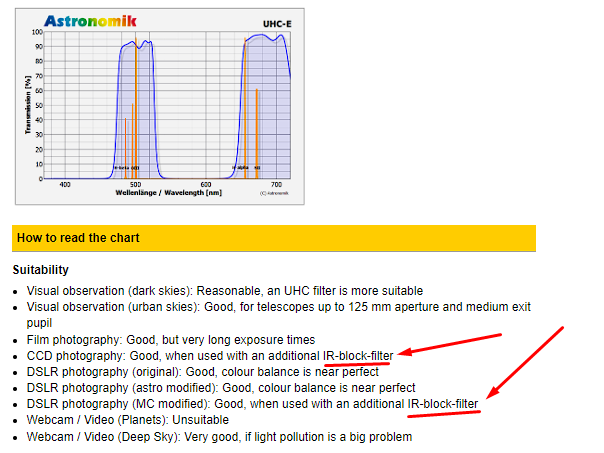 Here's a very old mistake of mine shooting that area w/o the UV/IR filter. 😬 That star is indeed a problem in IR! 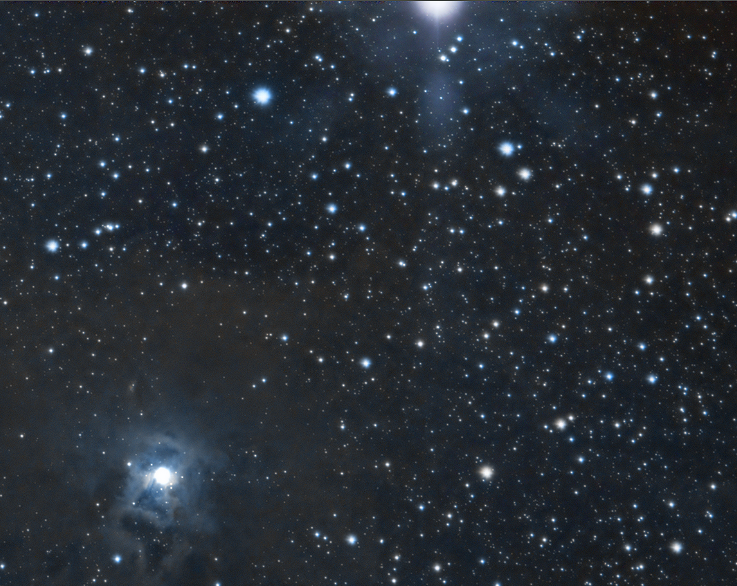 |
You cannot like this item. Reason: "ANONYMOUS".
You cannot remove your like from this item.
Editing a post is only allowed within 24 hours after creating it.
You cannot Like this post because the topic is closed.
Copy the URL below to share a direct link to this post.
This post cannot be edited using the classic forums editor.
To edit this post, please enable the "New forums experience" in your settings.
In our experience, Extreme has halos to a greater or lesser degree depending on speed of optics, Enhance not as much an issue and Ultimate virtually no halos in all optics we use from 135 F1.8 to Apo 130 F7.7. IDAS NBZ another superb filter with no halo but hard to get.
|
You cannot like this item. Reason: "ANONYMOUS".
You cannot remove your like from this item.
Editing a post is only allowed within 24 hours after creating it.
You cannot Like this post because the topic is closed.
Copy the URL below to share a direct link to this post.
This post cannot be edited using the classic forums editor.
To edit this post, please enable the "New forums experience" in your settings.
Rob:
Bill McLaughlin:
Short non-technical and practical version of the above is that the better (and often much more expensive) filters (Astro-Don, Chroma, Astronomik) are less likely to show these issues than the cheaper Chinese filters.
Not to compare apples to oranges here, but Astronomik has a similar filter issue. My Antlia filters aren't producing massive star halos. The closest I've seen was Sadr recently.

Here's a very old mistake of mine shooting that area w/o the UV/IR filter. 😬 That star is indeed a problem in IR!
 *** Rob. The filter you reference from Astronomik is a 45nm visual filter designed specifically to enhance comet and emission nebula visual observation. It was never designed for deep sky photography and does not have the same IR coatings as other filters specifically designed for photography. That is why they recommend adding an IR filter if you choose to try photography with it. As a long time user of Astronomik filters I can tell you they are high quality filters and they do not have the problem you are suggesting by by referencing a specialized visual filter into this discussion. Jeff ***
|
You cannot like this item. Reason: "ANONYMOUS".
You cannot remove your like from this item.
Editing a post is only allowed within 24 hours after creating it.
You cannot Like this post because the topic is closed.
Copy the URL below to share a direct link to this post.
This post cannot be edited using the classic forums editor.
To edit this post, please enable the "New forums experience" in your settings.
Your halos look similar to what I was experiencing in my tests I wrote about earlier here: https://www.astrobin.com/forum/c/astrophotography/equipment/askar-c2-filter-halo-tests-with-nir-sensitive-osc-cameras/I'm curious to know if you are using an IMX585 or IMX533 sensor?
|
You cannot like this item. Reason: "ANONYMOUS".
You cannot remove your like from this item.
Editing a post is only allowed within 24 hours after creating it.
You cannot Like this post because the topic is closed.
Copy the URL below to share a direct link to this post.
This post cannot be edited using the classic forums editor.
To edit this post, please enable the "New forums experience" in your settings.








